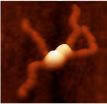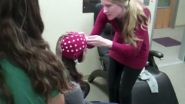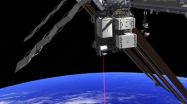(Press-News.org) SAN DIEGO (June 6, 2014) — Humans and corals are about as different from one another as living creatures get, but a new finding reveals that in one important way, they are more similar than anyone ever realized.
A biologist at San Diego State University has discovered they share the same biomechanical pathway responsible for triggering cellular self-destruction. That might sound scary, but killing off defective cells is essential to keeping an organism healthy.
The finding will help biologists advance their understanding of the early evolution of multicellular life, conservationists better understand the plight of modern corals, and medical researchers develop new drugs to fight diseases like cancer.
Steven Quistad, a graduate student working in the laboratory of SDSU virologist Forest Rohwer, made the discovery earlier this year somewhat by accident. Like Rohwer, Quistad has spent most of his research career so far studying viruses. Rohwer leads SDSU's Viral Information Institute, one of the university's Areas of Excellence. The cross-disciplinary institute explores interactions between viruses and the biosphere in order to improve human and environmental health.
While analyzing the proteins of the coral Acropora digitifera and matching them against human proteins, he found a peculiar similarity: Both had receptor proteins that receive signals from another protein called tumor necrosis factor, or TNF.
Orderly death
When TNF proteins attach themselves to a cell's TNF receptors, the cell launches into an orderly self-destruct mode. The protein strands inside the cell break down and the cellular components are cordoned off and carried away to be recycled. The process, known as apoptosis, plays a crucial role in cellular health, allowing defective cells to destroy themselves before they can cause damage to the organism.
When Quistad looked more closely at the coral's genome, he noticed that it had genes that coded for not just one TNF receptor, but 40 of them. TNF comes in many different "flavors," and each one matches with a particular receptor. The coral Quistad investigated had 14 different flavors of TNF and more TNF receptors than any other known organism on the planet. Humans, by comparison, have 25 TNF receptors.
So what would happen if you took the human version of a TNF protein and exposed it to a coral's TNF receptors?
Quistad and his colleagues did just that and watched for the telltale signs of apoptosis. Under a microscope, they saw evidence that the coral cell was breaking down within 10 minutes of exposure to human TNF. A series of other cellular signals associated with apoptosis confirmed it: Human TNF sets into motion programmed cell death in corals.
Vice versa?
Next, Quistad and colleagues wondered if coral TNF proteins would trigger apoptosis in human cells. They coaxed E. coli bacteria to express the same TNF proteins produced by corals and exposed them to cultured human tissue. Sure enough, apoptosis occurred in the human cells. Quistad published these results today in the Proceedings of the National Academy of Sciences.
The findings suggest that the pathway by which TNF triggers apoptosis is old. Extremely old.
"The fact that it goes both ways means that these domains haven't changed in half a billion years," Quistad said. "Corals are actually much more similar to humans than we ever realized."
That's interesting from an evolutionary biology perspective, Quistad said, because approximately 542 million years ago, organized life took off in a very big way.
Known as the Cambrian Explosion, this period saw the emergence of the early ancestors of much of the life that exists today, including humans. No one really knows what set off the Cambrian Explosion, but it's possible the evolution of orderly, systematic cell death played a leading role.
"TNF-induced apoptosis could turn out to be one of the major sparks of the Cambrian Explosion," Quistad said.
Coral conservation
Unfortunately, after half a billion years of success, corals today aren't doing so well. The effects of climate change and ocean pollution are taking their toll on the atolls. A fatal stress response known as coral bleaching, whereby corals expel the bacteria that give them their vibrant colors, is decimating corals around the world. Previous studies have linked apoptosis to this process, and indeed, the corals to which Quistad exposed TNF eventually bleached out.
A better understanding of how TNF mediates apoptosis in coral might allow conservationists to identify more resilient species, and then reintroduce these hardier corals to places where coral loss is hurting the local ecosystem, Quistad said.
Preserving and learning from these corals is important for human health, too. Corals are wonderfully complex organisms, Quistad said, and we're only beginning to learn their secrets.
"Many people look at a coral and think it's just a slimy rock," he said. "They think, 'How can it be so complex at a molecular level when it looks so simple?'"
Quistad said that by studying corals' various flavors of TNF proteins and TNF receptors, researchers might uncover medical properties useful for killing specific kinds of renegade cells, such as cancer cells.
"We have a lot to learn from corals about our own immune system," he said.
INFORMATION:
About San Diego State University
San Diego State University is a major public research institution offering bachelor's degrees in 89 areas, master's degrees in 78 areas and doctorates in 21 areas. The university provides transformative experiences, both inside and outside of the classroom, for its 35,000 students. Students participate in research, international experiences, sustainability and entrepreneurship initiatives, and a broad range of student life and leadership opportunities. The university's rich campus life features opportunities for students to participate in, and engage with, the creative and performing arts, a Division I athletics program and the vibrant cultural life of the San Diego region. For more information, visit http://www.sdsu.edu.
Coral, human cells linked in death
A new study finds that humans and corals share a key biomechanical pathway which tells cells when to die, providing important insights into both species' biology
2014-06-09
ELSE PRESS RELEASES FROM THIS DATE:
Researchers recast addiction as a manageable disease
2014-06-09
Neuroscientists agree that abuse of drugs hijacks circuits in the brain that are crucial for decision-making, but society as a whole tends to stigmatize addicted people for lacking self-control. Slowly but steadily, scientists say, they are making important progress in changing the perception of addiction as they identify new therapeutic interventions that could render addiction into the equivalent of a manageable disease like diabetes.
A group of addiction researchers, for one, recently recommended to the Commission on Narcotic Drugs, part of the United Nations Office ...
Protein could put antibiotic-resistant bugs in handcuffs
2014-06-09
DURHAM, N.C. -- Staph infections that become resistant to multiple antibiotics don't happen because the bacteria themselves adapt to the drugs, but because of a kind of genetic parasite they carry called a plasmid that helps its host survive the antibiotics.
Plasmids are rings of bare DNA containing a handful of genes that are essentially freeloaders, borrowing most of what they need to live from their bacterial host. The plasmids copy themselves and go along for the ride when the bacteria divide to copy themselves.
A team from Duke and the University of Sydney in ...
Parent and child must get enough sleep to protect against child obesity
2014-06-09
URBANA, Ill. – Is sleep one of your most important family values? A new University of Illinois study suggests that it should be, reporting that more parental sleep is related to more child sleep, which is related to decreased child obesity.
"Parents should make being well rested a family value and a priority. Sleep routines in a family affect all the members of the household, not just children; we know that parents won't get a good night's sleep unless and until their preschool children are sleeping," said Barbara H. Fiese, director of the U of I's Family Resiliency Center ...
Land quality and deforestation in Mato Grosso, Brazil
2014-06-09
PROVIDENCE, R.I. [Brown University] — The state of Mato Grosso is the epicenter of an agricultural revolution in Brazil. During the last 15 years, expansion of agriculture in the state has helped Brazil become one of the world's top producers of soy, corn, cotton, and other staple crops. Despite the increase in production, the rate at which Amazon forestland in the state was cleared to make room for new farmland slowed significantly in the second half of the last decade.
Much of the credit for slowing deforestation has been given to government policies and intervention, ...
Does 'free will' stem from brain noise?
2014-06-09
VIDEO:
UC Davis researchers found that the pattern of electrical activity in the brain immediately before making a decision can predict the choice made. This video shows how these experiments are...
Click here for more information.
Our ability to make choices — and sometimes mistakes — might arise from random fluctuations in the brain's background electrical noise, according to a recent study from the Center for Mind and Brain at the University of California, Davis.
"How ...
Humanitarian liking on Facebook
2014-06-09
"Liking" a page on the social networking site Facebook is a new form of civic engagement and humanitarian support, so concludes research published in the International Journal of Web Based Communities. According to the paper's authors social motives and an emotional response underpinned users' inclination to like, or follow, a page, rather than their simply seeking information and news.
Petter Bae Brandtzaeg and Ida Maria Haugstveit of Scandinavian research organization SINTEF in Oslo, Norway, surveyed more than 400 Facebook users about their habits on the site and their ...
Berkeley Lab researchers create nanoparticle thin films that self-assemble in 1 minute
2014-06-09
The days of self-assembling nanoparticles taking hours to form a film over a microscopic-sized wafer are over. Researchers with the U.S. Department of Energy (DOE)'s Lawrence Berkeley National Laboratory (Berkeley Lab) have devised a technique whereby self-assembling nanoparticle arrays can form a highly ordered thin film over macroscopic distances in one minute.
Ting Xu, a polymer scientist with Berkeley Lab's Materials Sciences Division, led a study in which supramolecules based on block copolymers were combined with gold nanoparticles to create nanocomposites that ...
'Hello, world!' NASA beams video from space station via laser
2014-06-09
"Hello, World!" came the message from the International Space Station as NASA successfully beamed high-definition video via laser from space to ground on Thursday, June 5. The 175-megabit video transmission was the first of its kind for the Optical Payload for Lasercomm Science (OPALS) with the goal of improving the way we receive data from orbit and beyond. In fact, this emerging technology of optical communications--or lasercomm--is likened to an upgrade from dial-up to DSL.
"It's incredible to see this magnificent beam of light arriving from our tiny payload on the ...
African-American women more likely to be diagnosed with higher risk breast cancer
2014-06-09
Washington, D.C., June 9, 2014 - A research study led by cancer specialists at MedStar Washington Hospital Center found that African-American women frequently present with biologically less favorable subtypes of breast cancer.
Researchers at the Hospital Center's Washington Cancer Institute analyzed the biology of breast cancer in 100 African-American women, using a method of genomic profiling. These genomic tests look at the expression of genes associated with the risk of recurrence in the population and further characterizes the biology of the tumor. The 70-gene MammaPrint ...
Affordable housing linked to children's test scores
2014-06-09
It's long been accepted – with little science to back it up – that people should spend roughly a third of their income on housing. As it turns out, that may be about how much a low-income family should spend to optimize children's brainpower.
Johns Hopkins University researchers have explored the effects of affordable housing on the cognitive development, physical health, and emotional wellbeing of children living in poverty. How much a family spends on housing has no impact on a child's physical or social health, they found, but when it came to cognitive ability, it ...
LAST 30 PRESS RELEASES:
Numbers in our sights affect how we perceive space
SIMJ announces global collaborative book project in commemoration of its 75th anniversary
Air pollution exposure and birth weight
Obstructive sleep apnea risk and mental health conditions among older adults
How talking slows eye movements behind the wheel
The Ceramic Society of Japan’s Oxoate Ceramics Research Association launches new international book project
Heart-brain connection: international study reveals the role of the vagus nerve in keeping the heart young
Researchers identify Rb1 as a predictive biomarker for a new therapeutic strategy in some breast cancers
Survey reveals ethical gaps slowing AI adoption in pediatric surgery
Stimulant ADHD medications work differently than thought
AI overestimates how smart people are, according to HSE economists
HSE researchers create genome-wide map of quadruplexes
Scientists boost cell "powerhouses" to burn more calories
Automatic label checking: The missing step in making reliable medical AI
Low daily alcohol intake linked to 50% heightened mouth cancer risk in India
American Meteorological Society announces Rick Spinrad as 2026 President-Elect
Biomass-based carbon capture spotlighted in newly released global climate webinar recording
Illuminating invisible nano pollutants: advanced bioimaging tracks the full journey of emerging nanoscale contaminants in living systems
How does age affect recovery from spinal cord injury?
Novel AI tool offers prognosis for patients with head and neck cancer
Fathers’ microplastic exposure tied to their children’s metabolic problems
Research validates laboratory model for studying high-grade serous ovarian cancer
SIR 2026 delivers transformative breakthroughs in minimally invasive medicine to improve patient care
Stem Cell Reports most downloaded papers of 2025 highlight the breadth and impact of stem cell research
Oxford-led study estimates NHS spends around 3% of its primary and secondary care budget on the health impacts of heat and cold in England
A researcher’s long quest leads to a smart composite breakthrough
Urban wild bees act as “microbial sensors” of city health.
New study finds where you live affects recovery after a hip fracture
Forecasting the impact of fully automated vehicle adoption on US road traffic injuries
Alcohol-related hospitalizations from 2016 to 2022
[Press-News.org] Coral, human cells linked in deathA new study finds that humans and corals share a key biomechanical pathway which tells cells when to die, providing important insights into both species' biology





